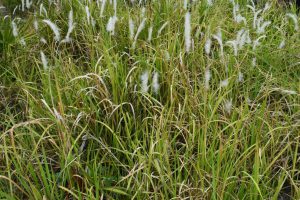
Cogongrass is an invasive species commonly found in pastures that is not going to go away on its own. Management of cogongrass invasions in perennial grass pastures requires diligence and patience at the same time. It can take several years to eradicate a single patch of cogongrass as there are no silver bullets or magic tank-mixes that result in 100% kill after only one application of herbicide. If you spray an area of cogongrass and it does not return, consider yourself lucky as this rarely happens. We are approaching the best time of year for cogongrass managment with herbicides, which is the reason for providing this information.
Herbicide options:
- Glyphosate (Roundup, others): There are many formulations of glyphosate on the market. Be sure, as with any herbicide, to read the label in its entirety prior to application. In general, applying a 3% solution of glyphosate is sufficient for top kill and some root kill with a single application.
- Imazapyr (Arsenal, Chopper, others): Application of imazapyr at a 1% solution is effective for spot treatment of cogongrass.
Which herbicide should I choose?
This is totally dependent upon your situation. If you have desirable trees in the area, you should avoid imazapyr and use glyhposate. If no desirable trees are in the area, imazapyr is the best option. You could also consider economics as glyphosate is much cheaper than imazapyr, but there is a tradeoff for selecting glyhposate over imazapyr. Using glyphosate usually requires retreatment within 6 to 8 months after the initial application, whereas you can wait 10 to 12 months before retreating with imazapyr.
Should I burn prior to herbicide application?
Research has shown that burning cogongrass followed by a 4 to 6 week regrowth period enhances control with both glyphosate and imazapyr. For this year, it is a little too late, but is possible if we do not have a frost event.
Need more information?
We have a fact sheet available that can be found here. This document provides a plan for cogongrass management in perennial grass pastures, as well as an integrated managment plan. For those wanting to broadcast herbicides onto cogongrass invasions, this information is also provided in the fact sheet.
 0
0
